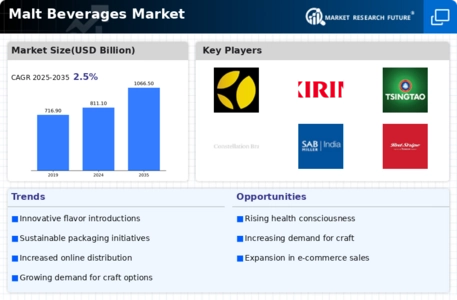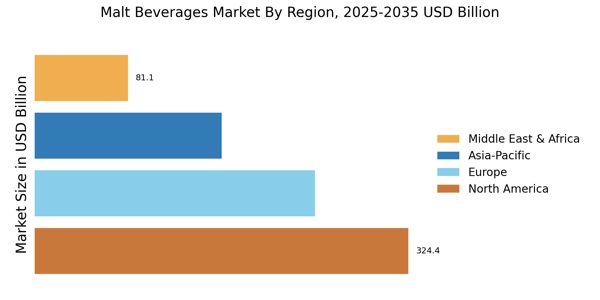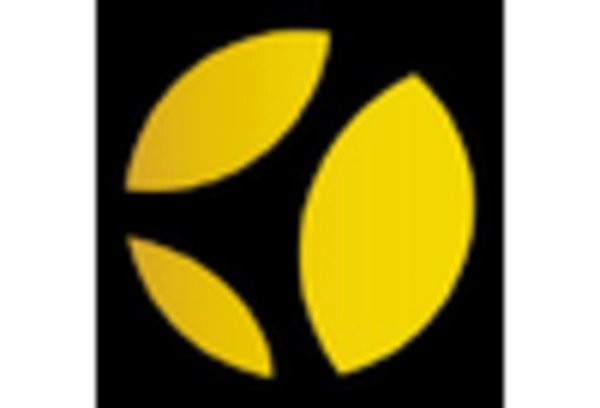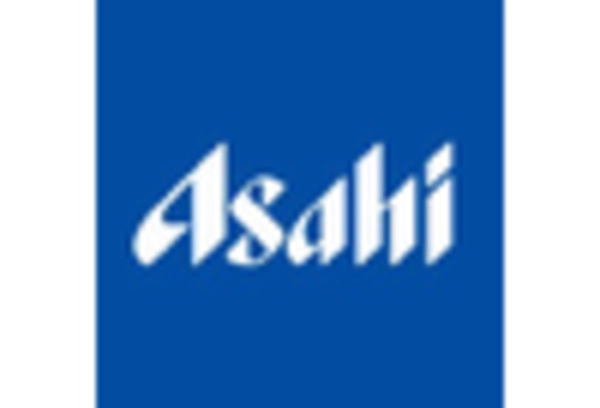Health Consciousness
The increasing awareness of health and wellness among consumers appears to be a pivotal driver in the Malt Beverages Market. As individuals become more health-conscious, they tend to seek beverages that align with their dietary preferences. This trend has led to a rise in demand for malt beverages that are lower in sugar and calories, as well as those enriched with vitamins and minerals. According to recent data, the market for health-oriented malt beverages is projected to grow at a compound annual growth rate of approximately 5% over the next five years. This shift in consumer behavior suggests that manufacturers in the Malt Beverages Market may need to innovate and reformulate their products to cater to this evolving demand.
Craft Beverage Movement
The craft beverage movement has gained substantial traction, influencing the Malt Beverages Market significantly. Consumers are increasingly drawn to artisanal and locally produced beverages, which are perceived as higher quality and more authentic. This trend has led to a proliferation of small-scale breweries and malt beverage producers, who emphasize unique flavors and traditional brewing methods. Data indicates that craft malt beverages have seen a remarkable increase in market share, with some segments reporting growth rates exceeding 10% annually. This burgeoning interest in craft products suggests that the Malt Beverages Market must adapt to the preferences of discerning consumers who prioritize quality and craftsmanship.
Diverse Flavor Profiles
The demand for diverse flavor profiles in beverages is reshaping the Malt Beverages Market. Consumers are increasingly seeking unique and innovative flavors that go beyond traditional offerings. This trend has prompted manufacturers to experiment with various ingredients, resulting in a wider array of malt beverages that cater to diverse palates. Recent market analysis indicates that flavored malt beverages are experiencing a surge in popularity, with sales projected to rise by 7% in the coming years. This inclination towards flavor exploration suggests that companies within the Malt Beverages Market may need to invest in research and development to create new and exciting products that resonate with adventurous consumers.
Sustainability Initiatives
Sustainability initiatives are becoming a crucial driver in the Malt Beverages Market as consumers increasingly prioritize environmentally friendly products. Companies are adopting sustainable practices in sourcing ingredients, packaging, and production processes to appeal to eco-conscious consumers. This shift is reflected in the growing number of brands that emphasize organic and sustainably sourced malt beverages. Market data suggests that the demand for sustainable products is expected to grow by 8% annually, indicating a significant opportunity for companies to differentiate themselves in the Malt Beverages Market. By aligning with sustainability trends, brands can enhance their appeal and potentially capture a larger share of the market.
Non-Alcoholic Beverage Growth
The rise of non-alcoholic beverages is a notable trend impacting the Malt Beverages Market. As consumers seek healthier lifestyle choices, the demand for non-alcoholic malt beverages is on the rise. This segment is particularly appealing to younger demographics who are increasingly opting for alcohol-free alternatives. Recent statistics indicate that the non-alcoholic malt beverage market is projected to grow by 6% over the next few years. This trend suggests that companies in the Malt Beverages Market may need to expand their product lines to include more non-alcoholic options, thereby catering to a broader audience and capitalizing on this growing consumer preference.


















Leave a Comment